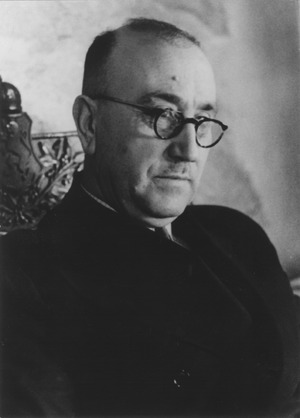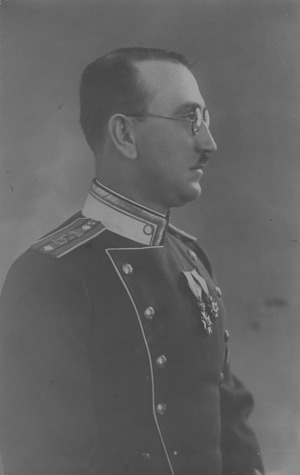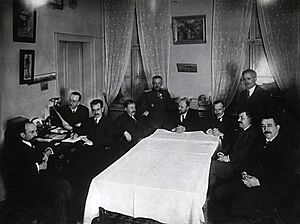Kimon Georgiev facts for kids
Quick facts for kids
Kimon Georgiev
|
|
|---|---|
| Кимон Георгиев | |
 |
|
| 24th Prime Minister of Bulgaria | |
| In office 19 May 1934 – 22 January 1935 |
|
| Monarch | Boris III |
| Preceded by | Nikola Mushanov |
| Succeeded by | Pencho Zlatev |
| In office 9 September 1944 – 22 November 1946 |
|
| Monarch | Simeon II (1944-1946) |
| President | Vasil Kolarov (1946) |
| Preceded by | Konstantin Muraviev |
| Succeeded by | Georgi Dimitrov |
| Personal details | |
| Born | 11 August 1882 Pazardzhik, Eastern Rumelia (today Bulgaria) |
| Died | 28 September 1969 (aged 87) Varna, Bulgaria |
| Political party | People's Alliance Democratic Alliance Zveno |
| Other political affiliations |
Fatherland Front |
| Spouse | Veska Rodeva |
| Children | Maria Georgieva, Kornelia Georgieva |
| Signature | |
| Nickname | Стария превратаджия (The old coup-maker) |
| Military service | |
| Branch/service | Bulgarian Army |
| Years of service | 1902–1935 |
| Rank | Colonel General |
Kimon Georgiev Stoyanov (Кимон Георгиев Стоянов; August 11, 1882 – September 28, 1969) was an important Bulgarian general and politician. He served as the Prime Minister of the Kingdom of Bulgaria two times. His first term was from 1934 to 1935, and his second was from 1944 to 1946.
Born in Pazardzhik, Kimon Georgiev started his military career in 1902. He later became involved in politics, playing a key role in the 1923 Bulgarian coup d'état. He also helped create the political group called Zveno. With the help of the Military Union, he led the 1934 Bulgarian coup d'état and became Prime Minister. However, King Boris III removed him from power in 1935.
Initially, Georgiev was seen as a strong leader who was against communism. Later, he became close to the Bulgarian Communist Party. This led to him becoming Prime Minister again after World War II, from 1944 to 1946.
Contents
- Early Life and Education
- Military Career
- Political Career
- Personal Life
- Death
- Awards
- Images for kids
- See also
Early Life and Education
Kimon Georgiev Stoyanov was born on August 11, 1882, in Pazardzhik, which was then part of Eastern Rumelia. He came from a middle-class family. His father passed away when Kimon was only three months old.
He finished his basic education in Pazardzhik in 1897. At first, he wanted to study engineering. However, his family could not afford to send him to study abroad. So, he decided to join the military instead. He was accepted into the Military University in Sofia.
Military Career
Kimon Georgiev graduated from the Military University in 1902. On January 1, 1902, he was promoted to second-lieutenant. He served as a commander in Peshtera and later in Pazardzhik. He was promoted to lieutenant in 1905.
Fighting in the Balkan Wars
When the First Balkan War began, Kimon Georgiev became a company commander. His unit was part of the Rhodope detachment. They advanced towards Mehomiya and helped capture Predela. His company also moved through several towns, supporting other divisions. In 1913, he was promoted to captain. He then became a commander of an infantry regiment in Kardzhali.
Service in World War I
During World War I, Kimon Georgiev was a company commander in the Forty-fourth Infantry Tundzhan Regiment. This regiment fought on the Salonika front. Georgiev showed great bravery in the fighting at Kayali. There, he captured 316 British soldiers. Because of his actions, he was promoted to major in 1916.
He also took part in the Battle of the Crna Bend. His unit held important positions against strong attacks. On October 19, he was severely wounded and lost one eye.
After recovering, Kimon Georgiev became an instructor. On February 27, 1918, he was promoted to lieutenant-colonel. After the war, he worked at the War Ministry.
Georgiev joined the Military Union, an organization for army officers. He helped organize its first meeting and was elected a member. In 1919, he was appointed commander of an infantry regiment in Sofia. However, he was later dismissed from the army in 1920. At that time, he was promoted to colonel.
Political Career
Joining the People's Alliance
After leaving the military, Kimon Georgiev started his political career in 1921. He helped found the People's Alliance. He also stayed connected with the Military Union. He worked to bring different opposition parties together to form the Constitutional Bloc in 1922.
The 1923 Coup d'état
Kimon Georgiev was a key leader in the Military Union. This group played a major role in the 1923 coup d'état. He was actively involved in uniting parties to create the Democratic Alliance. In November, he was elected as a deputy from Sofia.
In April 1925, Georgiev was wounded during the St Nedelya Church assault. This attack happened at a funeral he was attending. He later called the attackers "freaks" who were harming Bulgaria.
Serving in Andrey Lyapchev's Cabinet
At the end of 1925, Kimon Georgiev helped bring about changes in the government. On January 4, 1926, he became the Minister of Railways, Posts, and Telegraphs. This was part of Andrey Lyapchev's first government.
After leaving the cabinet, Georgiev became part of an opposition group. This group wanted the government to be more involved in the economy. They also wanted to stop political appointments and take action against the IMRO (Internal Macedonian Revolutionary Organization).
Founding the Zveno Political Circle
Kimon Georgiev founded the political circle "Zveno" with Damyan Velchev in 1927. At first, it was not a political party. Its goal was to improve the country's social and political situation. Zveno believed in a strong, central government that would act for the good of the nation.
Georgiev left the Democratic Alliance in 1930. He became a leader of Zveno. In 1932, Zveno started publishing a newspaper called Izgrev. Georgiev wrote articles criticizing communism and calling for a strong government to ensure order and economic control.
The 1934 Coup d'état
The 1934 coup d'état was carried out by the Military Union and Zveno. They removed Nikola Mushanov from power. Kimon Georgiev played a very important role in this event. At a meeting, it was decided to stage the coup on May 19. Damyan Velchev and Kimon Georgiev led the coup.
First Time as Prime Minister
Kimon Georgiev became Prime Minister on May 19, 1934, right after the coup. He also served as Minister of Foreign Affairs and Justice during this time.
His government quickly dissolved the National Assembly. They ruled by special laws signed by the king. On June 14, political parties and trade unions were banned. Their property was taken over by the state. The government also introduced strict censorship and banned many publications.
To help the economy, the government created state monopolies on grain, alcohol, and tobacco. They also helped people with their debts from the Great Depression. Several struggling private banks were combined into the Bulgarian Credit Bank.
The government also took strong action against the IMRO. They issued a law that made the IMRO illegal. Many IMRO activists were arrested, and their weapons and property were taken.
In foreign policy, Georgiev's government worked to improve relations with neighboring countries. They made a trade agreement with Yugoslavia. In July 1934, Bulgaria also established diplomatic relations with the Soviet Union for the first time.
By late 1934, there were disagreements within Zveno and the Military Union. King Boris III wanted to strengthen his own power. On January 22, 1935, Boris III carried out a counter-coup. Kimon Georgiev resigned, and Pencho Zlatev became the new Prime Minister.
Life in the Late 1930s
After being removed from power, Kimon Georgiev was watched by the police. He remained in contact with Damyan Velchev and other Zveno members. He also spoke with foreign diplomats.
He gave an interview to a Yugoslav newspaper, criticizing the new government. In April 1935, he was sent to St. Anastasia Island. Later, he was forced to leave Sofia for Burgas.
He was arrested briefly in October 1935 during a coup attempt by Velchev. However, he was released when no evidence was found against him. He continued to support Damyan Velchev during his trial.
Zveno became closer to left-wing groups like the BZNS (Bulgarian Agrarian National Union) and the Bulgarian Communist Party. Georgiev was always monitored by the government.
He tried to defend his actions after the 1934 coup in a pamphlet called "My Program." However, the authorities seized it, and he faced a trial, which was later dropped in 1939.
World War II and the Fatherland Front
When World War II began, Kimon Georgiev wrote to the Prime Minister. He suggested that Bulgaria should become closer to the Soviet Union. In November 1940, he supported a Soviet proposal for a mutual aid pact.
In January 1941, Georgiev and other political leaders asked King Boris III to keep Bulgaria neutral. He also wrote a long letter to the Prime Minister with the same request. However, Bulgaria later joined the Tripartite Pact and allowed German troops into the country.
The Communists contacted Kimon Georgiev, and Zveno joined the Fatherland Front. This was a group of different organizations working together. In August 1943, a National Committee of the Fatherland Front was formed, including Kimon Georgiev.
After King Boris III died in August 1943, Georgiev was among the opposition politicians consulted by the Prime Minister. He signed a declaration asking for the old constitution to be restored. He hoped this would change Bulgaria's foreign policy.
In early 1944, Kimon Georgiev tried to coordinate actions among opposition parties. He prepared a message to the government, asking for neutrality and better relations with the Soviet Union.
After heavy bombing, Kimon Georgiev moved to Burgas with his family. He was placed under house arrest there. He continued to communicate with the capital. In April, he signed a new appeal to the government to distance Bulgaria from Germany.
The 1944 Coup d'état
By late August, there were discussions about forming a new government. Kimon Georgiev was considered to lead a Fatherland Front cabinet. He refused to join a government without the Communists. On August 30, he signed a public statement from the Fatherland Front.
Georgiev's house became the center for planning the coup. Damyan Velchev even moved into his home. On September 6, armed guards were posted there.
On September 7, the Fatherland Front decided to carry out a military coup. Kimon Georgiev and other leaders met to plan the actions.
On September 8, Georgiev and other Fatherland Front representatives met with the Prime Minister. They protested against the dispersal of demonstrations.
Later that day, the leaders decided on the makeup of the new government. Kimon Georgiev was chosen to be the Prime Minister. This decision was even approved by Soviet leader Joseph Stalin.
The coup began at 2 a.m. on September 9. The War Ministry building was seized. By 6:25 a.m., Kimon Georgiev read a short message to the Bulgarian people over the radio. He announced the new government's formation.
Second and Third Times as Prime Minister
The new government's first goal was to improve relations with the Soviet Union. On September 9, a Bulgarian delegation was sent to meet with Soviet Marshal Fyodor Tolbukhin. Stalin then ordered Soviet military actions against Bulgaria to stop.
"Zveno" officially restarted its activities on September 18. On October 1, it became a political party called the People's Union "Zveno." Kimon Georgiev became its chairman.
The first few months of the new government saw strict control by the Communists. They controlled the interior and justice ministries. The government faced challenges in maintaining order and ensuring fairness. In mid-November, the Council of Ministers spoke out against violence, but it continued in some areas.
On October 10, Bulgaria withdrew its troops from parts of Macedonia and Thrace. On October 28, 1944, Bulgaria signed an armistice with the Allies. Bulgaria had to agree to tough conditions. These included supporting Soviet troops and joining the fight against Germany.
In December, a decree was passed to allow military officers charged under the People's Court Act to go to the front. If they showed bravery, they could be discharged. However, the Communists opposed this decree, and it was quickly canceled.
In January 1945, Kimon Georgiev visited Moscow. He met Joseph Stalin and Georgi Dimitrov for the first time. They discussed a possible alliance treaty between Bulgaria and Yugoslavia. However, this treaty was never signed due to opposition from Great Britain and the United States.
In February 1945, Kimon Georgiev gave a report on the government's work. He mentioned some "cases of self-destruction, arbitrariness and violence" that had occurred. He stated that the constitution and the rights of the Bulgarian people had been restored.
In the spring of 1945, tensions grew between the Communists and farmers in the Fatherland Front. This led to a split in the BZNS. Kimon Georgiev and Damyan Velchev met with Traicho Kostov. They received assurances that the Fatherland Front would remain a multi-party group. Georgiev stayed loyal to the Communists.
Georgiev's government planned elections for August 26, 1945. However, the United States and Britain pressured Bulgaria to postpone them. They wanted the elections to be fair. Stalin personally instructed that the elections be postponed until November. Opposition parties were then made legal. In the elections held on November 18, Kimon Georgiev was elected as a deputy.
In December, the United States and Britain said they would only recognize the Bulgarian government if two opposition members were included. Georgiev met with opposition leaders, but they refused to join. Georgiev was then summoned to Stalin, who criticized him for being too soft on the opposition.
In March 1946, Kimon Georgiev's government was reorganized. This was on Joseph Stalin's orders. Stalin wanted to strengthen the Communist presence in the cabinet. Despite the pressure, Georgiev remained Prime Minister.
In the summer of 1946, a purge began in the army. This involved public trials against alleged officer organizations. Kimon Georgiev publicly supported Damyan Velchev, calling him his "closest friend." However, Georgiev's influence in the government was limited. Velchev was eventually removed as minister.
From August to September, Kimon Georgiev was in Paris. He led a Bulgarian delegation preparing the Paris Peace Treaty. Bulgaria tried to be recognized as a country that fought against Germany. With the support of the Soviet bloc, Bulgaria managed to reduce the reparations demanded by Greece.
Upon his return, Georgiev helped Damyan Velchev avoid a show trial. Velchev was sent as ambassador to Switzerland. Georgiev was in charge of the War Ministry from September to November 1946. During this time, he was promoted to the rank of colonel general.
On October 5, 1946, Kimon Georgiev opened the Fatherland Front's election campaign. The Fatherland Front ran with a common list of candidates. While the Communists won a majority, Zveno had a poor result. Georgiev and other Zveno leaders became deputies only because of the Fatherland Front's common list.
Later Government Roles
After the elections and Bulgaria becoming a republic, Georgi Dimitrov became Prime Minister. Kimon Georgiev became Deputy Prime Minister and Minister of Foreign Affairs. In this role, he signed the Paris Peace Treaty on February 10, 1947.
In Georgi Dimitrov's second government (December 1947), Georgiev became Minister of Electrification and Land Reclamation. He held this position until 1959. He was also Deputy Prime Minister until 1950 and again from 1959 to 1962.
Kimon Georgiev was no longer part of the top political leadership. However, as Minister of Electrification, he played a very important role. Building power plants was key to the Communists' plan for industrialization. Between 1947 and 1959, electricity production in Bulgaria increased more than six times. Many power plants, dams, and transmission lines were built during this period.
In 1948, a secret investigation was started against Georgiev. This was due to tensions between Yugoslavia and the Soviet bloc. Georgiev was known for supporting friendly relations between Yugoslavia and Bulgaria. The investigation did not lead to public charges.
In 1949, the People's Union "Zveno" decided to dissolve itself. It joined the Fatherland Front completely. With this, Zveno stopped being an independent political organization.
Personal Life
Kimon Georgiev married Veselina Rodeva. They had two daughters, Maria (1928–1986) and Kornelia (born 1931). Maria became an agronomist and university lecturer.
When he was not involved in politics, Kimon Georgiev engaged in public work. He also supported himself from his wife's large vineyards. This brought him a good income. In the 1940s, he earned a lot of money from producing wine and grapes.
Death
Kimon Georgiev passed away suddenly from a stroke on September 28, 1969. He was at a government rest station in Varna. He had just visited a power plant that opened a month earlier. He was buried on September 30 in the Central Sofia Cemetery with state honors. Prime Minister Todor Zhivkov attended the ceremony.
Awards
From 1962 until his death in 1969, Kimon Georgiev was a member of the Presidium of the National Assembly. He received the title "Hero of Socialist Labour" twice, in 1962 and 1967.
Images for kids
See also
 In Spanish: Kimon Georgiev para niños
In Spanish: Kimon Georgiev para niños



